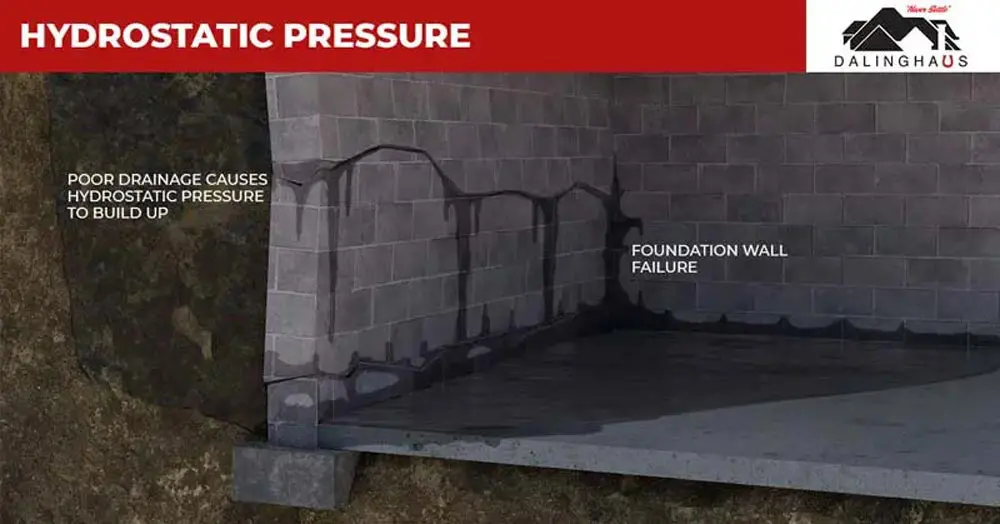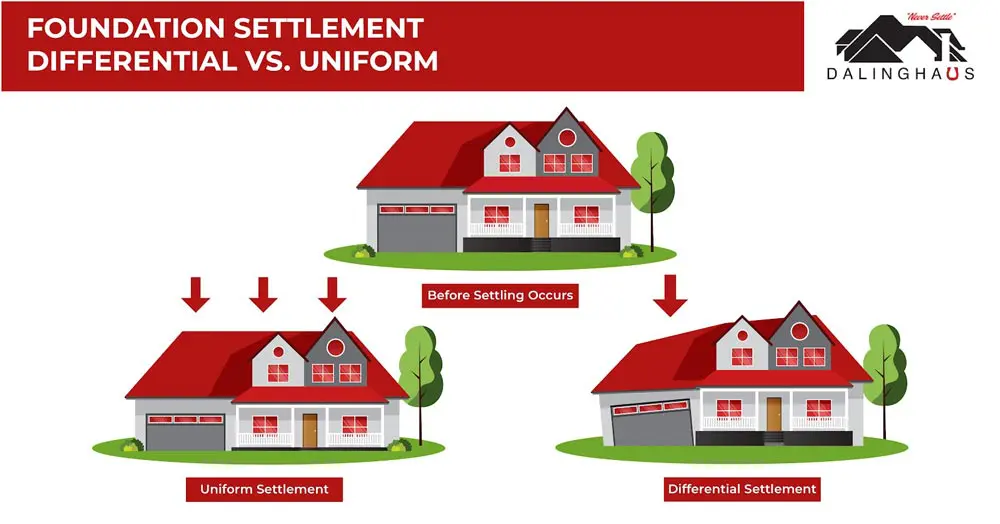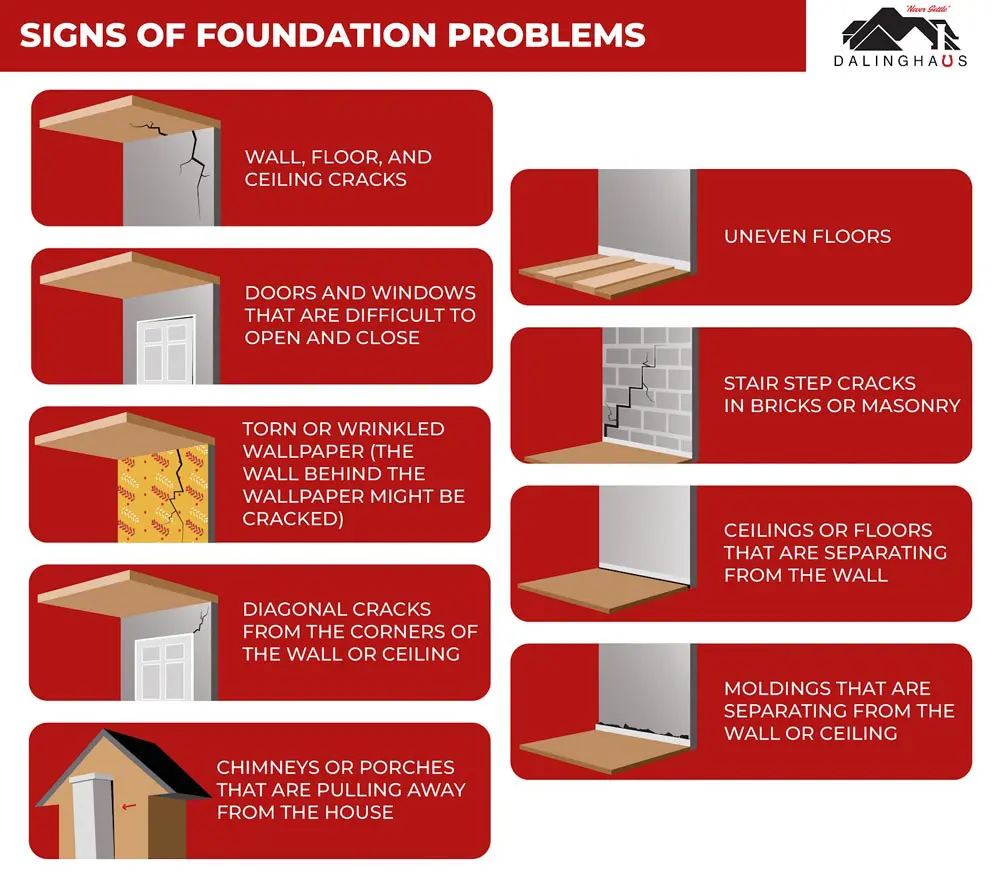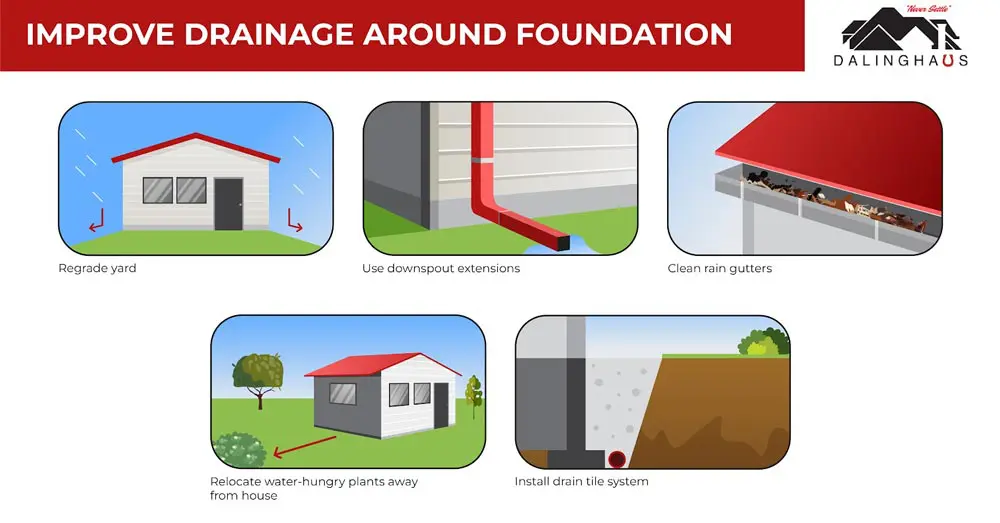Are you looking for information about landscaping next to a house’s foundation? If so, don’t hit that back button because you’ve landed on the right page. In this article, we’ll go over why water – which vegetation needs – is bad for your foundation, how you can make sure excess moisture can’t build up in the ground around your foundation, and more.
Water Is Bad For Your Foundation
Many homeowners are surprised to learn that water is the most common culprit behind foundation problems. When there’s too much or not enough water in the ground around a foundation, problems develop. Understanding the mechanisms behind water damage is crucial in preventing foundation issues. Here are the most common ways water can cause foundation damage:
Hydrostatic pressure can crack foundation walls
Water can cause foundation problems by exerting hydrostatic pressure against the foundation. Hydrostatic pressure builds up when water accumulates in the ground around the foundation and can’t drain off. The pressure pushes against foundation walls, and if it isn’t relieved, it will cause the foundation walls to bow inward and even crack eventually.
Hydrostatic pressure can also push water through invisible cracks in the foundation wall and into a basement or crawl space. Poor drainage can be exacerbated by sloping or uneven landscapes that push water toward the foundation walls.

Water-saturated soil loses its bearing capacity
Water can also cause foundation problems by saturating the soil beneath the foundation. When the soil becomes oversaturated with water, it loses its bearing capacity and becomes softer. This, in turn, can cause the foundation to settle unevenly into the ground (differential foundation settlement), creating additional stresses that can weaken the foundation’s structure.
Water can cause soil erosion under a foundation

Some soil types are prone to erosion, which can cause voids to form under the foundation. This can lead to differential foundation settlement, which can cause cracks and other issues.
Repeated freezing and thawing can damage a foundation
The freeze-thaw cycle is one of the most significant environmental factors that can cause damage to a foundation. This phenomenon primarily occurs in regions that experience significant temperature fluctuations, particularly during winter. When water penetrates the soil beneath the foundation, it can freeze and expand during colder periods. This expansion can exert significant pressure on the foundation, resulting in cracking, heaving, and other types of damage.
During the thawing process, the newly melted water can penetrate into cracks, and subsequent freezing can cause additional damage, making the foundation less stable over time.
Landscaping Next To A House’s Foundation Usually Means Adding Water To The Soil Around The Foundation
Unless you live in an arid region and plant vegetation that requires very little moisture, any flowers and shrubs you plant next to the foundation will need water. This is precisely what you’re trying to avoid because, as we’ve just noted, water is the most common cause of foundation trouble. So, to protect your home, you should skip landscaping next to the foundation. Keep all flowers, shrubs, and trees at least 3 feet from the foundation. They may look beautiful planted next to the house, but you’re asking for trouble unless they require virtually no water.
Common Signs Of Foundation Problems
Homeowners should know the most common signs of foundation problems to catch issues early when they’re less expensive to fix. These include the following:
- Wall, floor, and ceiling cracks – Horizontal wall cracks are the most problematic, and a crack that runs across the ceiling and down a wall is a sure indication of severe structural damage. Diagonal cracks from the corners of windows and doors are another sign of foundation trouble. While a single, hairline vertical crack in a foundation wall usually doesn’t affect the home’s structural integrity, a series of vertical cracks next to each other indicates something is wrong. When in doubt, contact a pro and ask for an inspection.
- Uneven floors
- Bowed and/or cracked foundation wall – This is often caused by hydrostatic pressure pushing against the wall.
- Stair step cracks in brick or masonry – This is a sure sign the foundation has moved.
- Chimneys or porches that are pulling away from the house
- Windows and doors that stick or no longer open and close properly
- A floor or ceiling that has separated from the wall
- Torn wallpaper – The wall behind the wallpaper might be cracked.
- Moldings that are no longer in contact with the wall or ceiling

If you see any of the above – or anything else that strikes you as suspicious – contact a foundation repair contractor right away and schedule a foundation evaluation. Most repair contractors will do the assessment for free. Whatever you do, don’t wait. Foundation problems worsen over time, and you’ll pay more for the repair if you wait. Act fast and save money.
For more information, see What Causes Horizontal Cracks In A Foundation Wall?
How To Help Prevent Foundation Trouble
Since the foundation plays a critical role in the stability and lifespan of your home, it’s essential to take the necessary steps to prevent any potential problems. Here are some things you can do to help avoid foundation problems.
Clean Your Gutters Regularly
It’s crucial to keep your gutters clean and free of debris. Clogged gutters can cause water to overflow the side of the house and soak into the ground around the foundation. Make sure to clean your gutters at least twice a year or more often if you have a lot of trees surrounding your property.
Use Downspout Extensions
Downspout extensions are an excellent way to direct rainwater away from your foundation. These extensions are easy to install and help to prevent water from pooling around your home. Ensure the downspout extensions release runoff at least six feet away from your foundation to avoid water damage.
Regrade The Yard Around the Foundation
If the ground around your foundation slopes towards your home, water can accumulate and cause damage. By regrading the yard around your foundation, you can divert water from your home and prevent potential problems. Make sure the yard gently slopes away from your foundation to encourage proper drainage.
Don’t Plant Vegetation Next to Your Foundation
While plants and shrubs may add to your home’s curb appeal, they can cause serious damage to your foundation. The roots of plants can grow deep into the ground and cause cracks in your foundation, allowing moisture to seep through. They also need water, and you’re trying to avoid excess moisture in the soil around the foundation. It’s best to keep vegetation at least three feet away from your foundation to prevent potential problems.
Install a Drain Tile System
Installing a drain tile system is one of the best ways to prevent foundation problems. A drain tile system is a series of pipes buried around your foundation to divert water from your home. This system helps to prevent excess moisture from building up in the soil and causing damage to your foundation. A drain tile system is critical in an area with heavy rainfall or a high water table.

If you’re considering landscaping next to your home’s foundation, and need expert advice, contact us today. We serve Southern California, Arizona, and Nevada.






